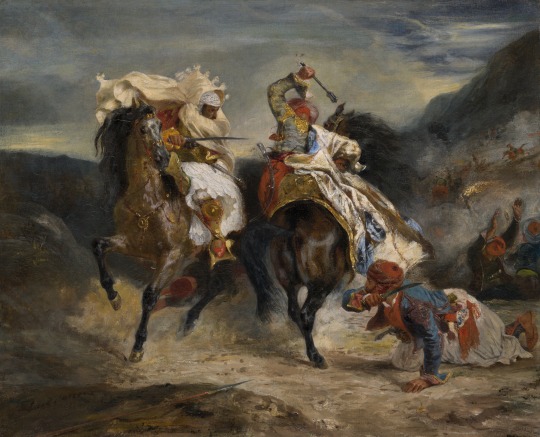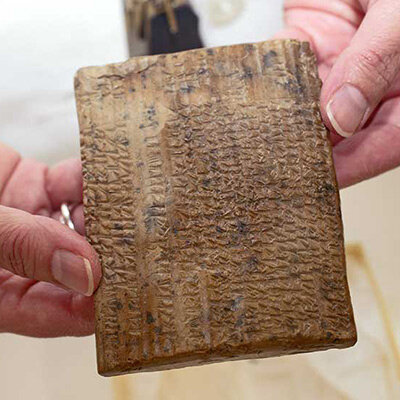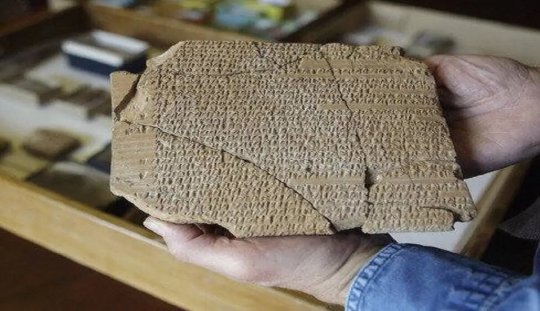#oriented institutes
Explore tagged Tumblr posts
Text

The Combat of the Giaour and Hassan
Artist: Eugène Delacroix (French, 1798–1863)
Date: 1826
Medium: Oil on canvas
Collection: Art Institute of Chicago, Chicago, IL, United States
Description
This colorful scene was inspired by a poem from Lord Byron’s “Oriental tales,” a popular series of romances. Both the poem and the painting are examples of 19th-century Europeans’ interest in fantastical and often violent depictions of Middle Eastern, North African, and Asian cultures, which reinforced colonialist aims. Although Eugène Delacroix did not visit North Africa until 1832, he began painting Orientalist subjects early on in his career. The artist’s French audience would have been receptive to his choice of jewel-like colors to describe the shimmering, gold-braided vest and billowing robes of the central figures. Far from accurately representing the attire of the 17th-century combatants of Byron’s poem, Delacroix drew upon styles worn by the Turko-Egyptian Mameluke warriors during Napoleon Bonaparte’s military campaign in Egypt in 1798–99.
#painting#literary scene#lord byron's oriental tales#landscape#orientalism#oil on canvas#artwork#fine art#oil painting#turkish costume#battle scene#narrative art#horses#art and literature#poetry#french culture#french art#eugene delacroix#french painter#european art#19th century painting#art institute of chicago
32 notes
·
View notes
Text

Panthea, Cyrus, and Araspas
Artist: Laurent de La Hyre (French, 1606-1656)
Date: 1631-1634
Medium: Oil on canvas
Collection: Art Institute of Chicago, Chicago, IL, United States
Description
This is one of two surviving paintings from Laurent de La Hyre’s series illustrating the story of Queen Panthea’s capture by the armies of Cyrus the Great, the ancient king of Persia. Cyrus, shown here in blue, refused even to gaze upon the beautiful queen, choosing instead to concentrate on affairs of state and turning her care over to his friend Araspas, who ultimately fell in love with her to tragic consequences.
Cyrus II of Persia (c. 600 – 530 BC), commonly known as Cyrus the Great, was the founder of the Persian Achaemenid Empire. Hailing from Persis, he brought the Achaemenid dynasty to power by defeating the Median Empire and embracing all of the previous civilized states of the ancient Near East, expanding vastly and eventually conquering most of West Asia and much of Central Asia to create what would soon become the largest polity in human history at the time. The Achaemenid Empire's largest territorial extent was achieved under Darius the Great, whose rule stretched from Southeast Europe in the west to the Indus River valley in the east.
#ancient history#painting#cyrus the great#historical scene#narrative art#oil on canvas#conversation piece#drapery#oriental costume#persian achaemenid empire#columns#door#female figure#male figures#panthea#cyrus#araspas#artwork#fine art#oil painting#french culture#french art#laurent de la hyre#french painter#european art#17th century painting#art institute of chicago
23 notes
·
View notes
Text

Boaz Questions Ruth in the Field (Ruth 21:4)
Artist: Gerbrand van den Eeckhout (Dutch, 1621–1674)
Date: 1651
Medium: Oil on canvas
Collection: RKD Netherlands Institute for Art History, The Hague, Netherlands
Boaz Questions Ruth in the Field | Ruth 2:1-4
Now Naomi had a relative on her husband’s side, a man of standing from the clan of Elimelek, whose name was Boaz. And Ruth the Moabite said to Naomi, “Let me go to the fields and pick up the leftover grain behind anyone in whose eyes I find favor.” Naomi said to her, “Go ahead, my daughter.” So she went out, entered a field and began to glean behind the harvesters. As it turned out, she was working in a field belonging to Boaz, who was from the clan of Elimelek. Just then Boaz arrived from Bethlehem and greeted the harvesters, “The Lord be with you!” “The Lord bless you!” they answered.
#ruth#boaz#landscape#book of ruth#grain field#biblical narrative#biblical scene#biblical art#christianity#biblical story#christian art#men#oriental costume#hills#trees#painting#oil on canvas#fine art#oil painting#artwork#biblical#christian faith#dutch culture#dutch art#gerbrand van eeckhout#dutch painter#european art#17th century painting#netherlands institute for art history
22 notes
·
View notes
Text

The Combat of the Giaour and Hassan
Artist: Eugène Delacroix (French, 1798–1863)
Date: 1826
Medium: Oil on canvas
Collection: Art Institute of Chicago, Chicago, IL, United States
Description
This colorful scene was inspired by a poem from Lord Byron’s “Oriental tales,” a popular series of romances.
Delacroix completed his first painting of the combat of Giaour and Hassan, showing the two on horseback, fighting in a gorge. A Turk escorting Hassan kneels beside the Giaour's horse, trying to cut its legs with his knife.
#literary art#landscape#combat#giaour#hassan#literary characters#oriental tales#lord byron#literature#equestrian#horses#gorge#battle scene#men#turkish costume#oil painting#artwork#fine art#oil on canvas#french art#french culture#eugene delacroix#french painter#european art#19th century painting#art institute of chicago
31 notes
·
View notes
Text

Tutankhamun, University of Chicago.
2 notes
·
View notes
Text
Ancient Treasures Beeing Uncovered Waiting Excibition

TEHRAN - More than two months have passed since the recovery of 3506 Achaemenid tablets, and the time for their unveiling has not yet been determined. However, the director of the National Museum of Iran announced their imminent display in this museum soon.
It was late in September that 3506 Achaemenid tablets were returned to Iran after nearly 90 years, accompanying the President's plane.
The treasured tablets were returned home by the plane carrying President Ebrahim Raisi, who addressed the 78th session of the United Nations General Assembly during his visit to New York.
These clay tablets were part of a larger shipment discovered at Persepolis in 1311, which was entrusted to the Oriental Institute of Chicago for deciphering and study.
Out of over 30,000 pieces held by the Chicago Institute for study and deciphering, five shipments have been returned to Iran in the Iranian years 1327 (1948-49), 1330 (1951-52), 1383 (2004-05), 1398 (2019-2020), and 1402 (2023-24), ISNA reported.
Yet, portions of these tablets still remain at the institute. Ezzatollah Zarghami, the Minister of Cultural Heritage, Tourism, and Handicrafts, had previously mentioned the process of returning the remaining tablets, stating that the groundwork for their return has been laid out. “According to an agreement made by the Americans, our experts will go to that country to verify the remaining tablets, after which they will gradually be returned to Iran.”
However, the fifth shipment, arriving in Iran on September 21 this year, consisted of 836 small tablets in Aramaic script and 2670 large tablets in Elamite script. They were shipped in nine boxes each weighing 75 kg. They were ultimately delivered to the National Museum of Iran.
It was planned that after quarantine, inspection, and study, some of these tablets would be put on display. Jebrael Nokandeh, the director of the National Museum of Iran, responding to ISNA regarding the timing of their display, stated: “It will be showcased soon.”.

He had previously mentioned the possibility of showcasing the Achaemenid tablets during Research Week (Dec. 16 to 20), but upon ISNA's follow-up, he responded: "The time for display (of the fifth shipment of recovered Achaemenid tablets) is approaching."
Studies conducted thus far on the Achaemenid clay tablets indicate that their content encompasses the administration and upper echelons of society during that historical period.
Archaeologists affiliated with the University of Chicago discovered the tablets in the 1930s while excavating in Persepolis, the ceremonial capital of the Persian Empire. However, the institute has resumed work in collaboration with colleagues in Iran, and the return of the tablets is part of a broadening of contacts between scholars in the two countries, said Gil Stein, director of the Oriental Institute at the University of Chicago.
They are very important sources of information revealing economic, social, and religious data about the Achaemenid Empire (550-330 BC) and the larger Near Eastern region in the fifth century BC.
Persepolis, locally known as Takht-e Jamshid, was the ceremonial capital of the Achaemenid Empire. It ranks among the archaeological sites, that have no equivalent, considering its unique architecture, urban planning, construction technology, and art.
Narratives say that Persepolis was burnt by Alexander the Great in 330 BC apparently as revenge against the Persians because it seems the Persian King Xerxes had burnt the Greek City of Athens around 150 years earlier. It was the largest and most durable empire of its time, stretching from Ethiopia, through Egypt, to Greece, Anatolia (modern Turkey), Central Asia, and India at its height.
Source:https://www.tehrantimes.com/news/491889/Achaemenid-tablets-recovered-from-U-S-when-will-they-be-unveiled
#Iran#clay tablets#Ancient Iran#Achaemenid#Iran Tehran#New York#Oriental Institute of Chicago#Iranian Minister of Cultural Heritage#Tourism and Handicrafts#Jebrael Noccandeh#iran culture#ایران#arhcaeology#وزیر میراث فرهنگی، گردشگری و صنایع دستی#ایران باستان#باستان شناسی#موسسه شرقی شیکاگو#هخامنشی
8 notes
·
View notes
Text
How Old Are The Egyptian Pyramids? And Why Did The Ancient Egyptians Build Pyramids In The First Place?
— By Owen Jarus | August 30th, 2023

The Pyramids of Giza, seen here with the Milky Way in the background, are not Egypt's oldest Pyramids. Image Credit: Getty Images
Pyramids are iconic symbols of the ancient pharaohs' power and technological prowess that still dominate the Egyptian skyline. But when were pyramids first built? And why were they constructed in the first place?
The first pyramid in Egypt was built by the pharaoh Djoser, who reigned nearly 4,700 years ago. More than a millennium later, ancient Egypt's last pyramid built for a pharaoh was constructed for Ahmose I around 3,500 years ago. After that, Egyptian rulers were buried in underground tombs in the Valley of the Kings.
Put another way, the ancient Egyptian pyramids were built between about roughly 2700 B.C. and 1500 B.C. This makes the earliest pyramids about the same age as Stonehenge, which was initially built between 4,000 to 5,000 years ago. But the pyramids are much older than other ancient structures, including the Parthenon (447 B.C.), the Great Wall of China (220 B.C.) and the Colosseum (A.D. 80). The Neolithic temple Gobekli Tepe in Turkey, however, is older from 11,000 to 12,000 years ago.
Egypt's First Pyramid
Djoser's pyramid is made up of six layers and was originally built as a type of rectangular tomb known today as a mastaba (an Arabic word meaning "bench") before being expanded into a step pyramid.
Ancient inscriptions indicate that a man named Imhotep directed the step pyramid's construction. "Imhotep is usually regarded as the first architect in Egypt to build in stone and is credited with the building of Djoser's step pyramid complex" Marc Van De Mieroop, a professor of history at Columbia University, told Live Science in an email. "There's an inscription with his name combined with that of Djoser in which he is called chief of sculptors. In later ancient Egypt he was considered a sage," Van De Mieroop added.

The Step Pyramid of Djoser is the oldest Pyramid in Egypt. Image Credit: Anton Petrus / Getty Images
Why Did The Egyptians Build Pyramids?
Researchers are still unsure exactly why pharaohs chose to use pyramids for their burials.
One reason may have been to provide added protection against tomb robbers. In earlier times robbers plundered pharaohs' low-rising mastaba tombs by burrowing in from the top, Egyptologist Reg Clark wrote in his book "Securing Eternity: Ancient Egyptian Tomb Protection from Prehistory to the Pyramids" (American University in Cairo Press, 2019). The step pyramid, with its six layers on top of each other, would have offered protection from this method, Clark wrote. "Many Egyptologists have suggested that the step pyramid formed a kind of 'stairway' for the king to ascend to the sky, but I suggest that [it was built] because it is the most efficient and economical way to create a virtual 'hemisphere' of protection over the underlying substructure," Clark told Live Science in an email.
Another important innovation was that stone was used to build the step pyramid, whereas the mastabas used by previous pharaoh were made of mudbrick; this was important as stone is harder to infiltrate, Clark noted.
Religious reasons may also have been an important factor. Miroslav Verner, a professor emeritus of Egyptology at Charles University in the Czech Republic, told Live Science in an email that "probably religious reasons were behind" the idea to build pyramids.
When Djoser came to power, the influence of the sun cult and the sun god Ra (also spelled Re) was increasing, Verner wrote in his book "The Pyramids: The Archaeology and History of Egypt's Iconic Monuments" (American University in Cairo Press, 2021). The sun cult's growing influence may have led to a desire to build structures that reached higher into the sky. Verner noted that a passage from a text dating back around 4,400 years said "may the sky make the sunlight strong for you, may you rise up to the sky as the Eye of Re" (Translation by Raymond Faulkner).
One question is whether a growing interest in the sun cult brought about the construction of the step pyramid, or whether the construction of the step pyramid brought about an increasing interest in the sun cult. "What came first, the egg or the chicken?" Massimiliano Nuzzolo, a researcher at the Institute of Mediterranean and Oriental Cultures of the Polish Academy of Sciences in Warsaw, told Live Science in an email.
Nuzzolo thinks that interest in the solar cult grew after the construction of the step pyramid. "This incredible architectural enterprise may have also affected and somehow even pushed for a change in the religious ideology, eventually reflected on a major emphasis on the solar aspects of the kingship," Nuzzolo said.

The Bent Pyramid, built under ancient Egyptian Pharaoh Sneferu, is named for its unique angles. Image Credit: Getty Images
Built For A Millennium
Whatever the reasons for building pyramids, Egyptian pharaohs constructed them for more than a millennium. The pharaoh Sneferu (reign circa 2575 to 2551 B.C.) built the first true pyramids (pyramids with flat sides) at Dahshur. These consisted of the Bent Pyramid (so named because of its unusual angle) and the Red Pyramid (named after its color). The Great Pyramid at Giza, the only one of the seven ancient wonders of the world that still stands, was built by Khufu (reign circa 2551 to 2528 B.C.) while Khafre (reign circa 2520 to 2494 B.C.) built another large pyramid, along with the Great Sphinx, at Giza.
It's not clear why Egyptian pharaohs stopped building pyramids, but security concerns may have been part of it. Despite likely being harder to loot than mastabas, Egyptian pyramids were plundered in ancient times, and pharaohs may have hoped that building their tombs in the Valley of the Kings would make them harder to ransack. Additionally, the topography of the valley has a peak that today is called el-Qurn (sometimes spelled Gurn), which looks a bit like a natural pyramid.
#The Egyptian 🇪🇬 Pyramids#The Ancient Egyptians#Ancient Pharaohs#Egyptian Skyline#Construction Dates#Pharaoh Djoser#Ahmose I#Burials | The Valley of The Kings#Stonehenge | Salisbury | England 🏴#Parthenon | The Great Wall of China 🇨🇳 | The Colosseum | Italy 🇮🇹 | The Neolithic Temple Gobekli Tepe | Turkey 🇹🇷#Imhotep#Marc Van De Mieroop | Professor | Columbia University#Egyptologist Reg Clark#Miroslav Verner | Professor Emeritus of Egyptology | Charles University | Czech Republic 🇨🇿#American University | Cairo | Egypt 🇪🇬#Raymond Faulkner#Massimiliano Nuzzolo#Institute of Mediterranean| Oriental Cultures | Polish Academy of Sciences | Warsaw | Poland 🇵🇱#Live Science#Bent Pyramid | The Great Pyramid of Giza#The Great Sphinx#El-Qurn
9 notes
·
View notes
Text
i am finally alive again after 2.5 days of being so sick i wasn't sure what timezone i was in. apparently i missed two mandatory meetings this week because i couldn't access my institutional email. i only signed up for payment and health insurance yesterday because HR just established that i am a person on like, tuesday. my start date was the first of the month.
#welcome to academia#i think maybe i was really spoiled by going to a state institution#where state laws require they onboard you two months in advance and remotely#i'm sure i'm pissing everyone off but also...i was barely standing upright on monday when i went to the fellows orientation#like i literally could not have gotten here sooner without sacrificing mine and my loved ones' wellbeing#so...................work with me here
3 notes
·
View notes
Text
erik alfred leslie satie you were the real one
#i mean that on all accounts. however. currently i am referring to the fact he dropped out of paris conservatoire twice#we both were too silly for the art music educational institutions 😔😔#being into avant-garde ideas and some of the styles sucks. how tf i dont fit in BOTH art and pop music standards and expectations#composition class is a f-g nightmare when you are schizoid (not into any poetry and expressing 'feelings' no matter mine or someone else's)#my professor doesnt allow pieces without an Idea; a Picture that is Painted by Notes. more they dont even exist to her.#and then theres me. flat affected fucker who rarely has Ideas (and even if i do neither i want to nor can explain them) but often Neat#Sound Combinations. oh and also most of the conventional themes/ideas disgust me (see: 95% of poetry and songs being about l*ve)#sigh why cant i just magically be left alone to finally live my truth#the orientation to the listener and their basic ass perception while writing music and yk. expressing _yourself_ by it is so sickening
1 note
·
View note
Text
Top Computer Courses to Pursue after 12th to get placed
Looking to pursue computer courses after 12th? Unlock a world of opportunities with the best computer courses in Delhi. From web development to data science and digital marketing, these courses empower you with the skills needed to thrive in the digital age. Choose the best computer course in Delhi and embark on a rewarding career journey.

#Best computer courses after 12th#Best computer course after 12th#Computer courses in Delhi#Computer course in Delhi#Basic computer course in Delhi#Computer institute in Delhi#Best computer course in Delhi with placement#computer courses#computer science#students#courses after 12th#job oriented courses#career guidance
2 notes
·
View notes
Text
being a Bishop is a job, and the Pope is your boss (or great-great-great-etc-grandboss, anyway).
mans got fired. isn't Texas an at-will employment state as well? meaning your boss can fire you for any reason*?
*as long as that reason is not based on sex, race, gender, sexual orientation, or religion

There’s nothing funnier than American Trad Caths revealing that they’re just Presbyterians that think Baroque looks cool
#and there are some exceptions for religious institutions#they can legally discriminate against people based on gender/gender identity/sexual orientation
69K notes
·
View notes
Text
Contact Adarsh Paramedical Institute Pune | Job-Oriented Healthcare Courses & Education 📞
Looking to connect with the best paramedical institute in Pune? Visit the official contact page of Adarsh Paramedical Institute Pune to get in touch with our expert counselors and take the first step toward a successful healthcare career.
We are here to assist you with: ✅ Paramedical Institute Contact Pune ✅ Paramedical Inquiries in Pune ✅ Paramedical Education Contact Pune ✅ Job-Oriented Healthcare Courses
Whether you are a student, working professional, or parent seeking detailed information on career-focused paramedical education in Pune, our team is ready to guide you with admission procedures, course structures, and placement support.
Adarsh Paramedical Institute offers a wide range of diploma, degree, and certification courses in medical lab technology, X-ray technology, operation theatre technology, and more, designed to help you build a successful career in the healthcare sector.
🎓 Why Contact Us?
Personalized career guidance
Fast-track job-oriented courses
Affordable education with placement support
Recognized certifications for medical careers

📍 Click the link below to visit our contact page: 👉 https://adarshparamedical.com/contact.php
#Paramedical Institute contact Pune#Paramedical inquiries in Pune#Paramedical education contact Pune#Job-oriented healthcare courses
0 notes
Text
What are Java Variables and Why Are They Important in Programming?
When you first dive into Java, one of the main things you'll come across is variables. So, what are Java variables and why do they matter in programming? Simply put, they’re like containers that hold data for your program. They give you the flexibility you need to create cool applications. Grasping this idea is key to starting any Java course in Coimbatore.
The Basics of Java Variables
At the heart of it, Java variables are placeholders for data. Each variable has a specific type such as int, float, or String, which tells you what kind of data it can hold. Without them, managing data in your application would be tough. Knowing how to declare and use them is a must if you're looking at a Full Stack Developer Course in Coimbatore.
Types of Java Variables
Java has a few types of variables: local, instance, and static. Local variables exist only in methods, instance variables are tied to objects, and static variables belong to the class itself. Understanding these differences will help clarify what variables are and why they’re important in programming. You’ll go over this in detail during any professional Java training in Coimbatore.
Why Java Variables Matter
Java variables are important because they help developers write clean and logical code. They make it easier to reuse code and manage user input data effectively. This is why they are a key topic in any Java course in Coimbatore.
Declaring and Initializing Variables
To declare a variable in Java, you write the data type followed by the variable name, like so: `int age = 25;`. You can also set a value at a later point. This simple way of managing data shows why variables are important—they help you keep things organized, which is a vital skill you’ll learn in a Full Stack Developer Course in Coimbatore.
Scope and Lifetime of Variables
The scope of a Java variable refers to where it can be used in your code. For instance, a local variable is only available in the method where it's created. Getting a handle on variable scope will help you understand their importance in programming. You'll find this topic covered in detail during Java training sessions in Coimbatore.
Best Practices in Using Variables
Using clear variable names, keeping their scope small, and initializing them before use are some good habits that make programming easier. These practices show you what variables are and why they're important, and they’re stressed in every advanced Java course in Coimbatore.
Variables in Full Stack Development
In full stack Java development, variables are used in both the front-end and back-end parts of apps. They play a role in everything from handling UI inputs to managing databases. That’s why understanding what variables are and why they matter becomes even more relevant in a Full Stack Developer Course in Coimbatore where real-world projects are tackled.
Common Errors and Debugging Tips
Beginners often run into issues like forgetting to initialize variables or using the wrong data type. Spotting these mistakes is a big part of learning about variables. Regular debugging sessions and hands-on practice in Java training in Coimbatore can help you work through these challenges.
Conclusion: Build Your Java Skills with Xplore IT Corp
To really get a grip on what Java variables are and why they matter, practical experience is essential. Whether you’re starting out or aiming for a full stack role, a solid understanding of variables and similar concepts is crucial. Sign up for a Java Course, Java Training, or Java Full Stack Developer Course in Coimbatore with Xplore IT Corp to kickstart your Java programming journey.
FAQs
1. What are Java variables?
Java variables are storage spots for data that can change while the program runs.
2. Why are variables important in Java programming?
They help in handling data, keeping your code clean, and supporting dynamic data operations.
3. Are Java variables covered in a full stack course?
Yes, they're a key part of programming logic and are thoroughly covered in a Full Stack Developer Course.
4. Can I learn about Java variables online in Coimbatore?
Definitely! Most online Java training programs cover variables and data types.
5. Is mastering variables necessary before learning advanced Java?
Yes, they are a fundamental concept, and getting a handle on them is important before moving on to more advanced topics.
#Java data types#variable declaration in Java#Java variable scope#types of variables in Java#Java programming basics#object-oriented programming in Java#local variables in Java#instance variables in Java#static variables in Java#Java syntax#Java full stack developer skills#Java coding for beginners#Java development training#Java backend programming#Java learning institute in Coimbatore
0 notes
Text

Join the best digital marketing course in Indore at MindCoders and master the skills that drive real results. Learn SEO, Google Ads, Social Media Marketing, Email Marketing, Content Strategy, and Analytics — all with hands-on training and live projects. Whether you're a student, entrepreneur, or job seeker, MindCoders helps you become industry-ready with expert mentorship and 100% practical learning.
#Digital Marketing#Best Digital Marketing Course in Indore#SEO#Google Ads#Social Media Marketing#Digital Marketing Institute Indore#Learn with MindCoders#Online Marketing Training#Marketing Strategy#Job-Oriented Course
0 notes
Text
When miraculously Treasures return home
On the evening of September 20,Thursay, when Iran’s presidential jet touched down in Tehran, it bought the fourth batch of Achaemenid clay tablets from the U.S., where they had been kept on loan for nine decades.

A total of 3,506 Achaemenid tablets were returned home by the plane carrying President Ebrahim Raisi, who addressed the 78th session of the United Nations General Assembly during his visit to New York.
The recovered collection consists of 836 small tablets written in Aramaic and 2,670 large tablets with cuneiform inscriptions in Elamite, CHTN reported.
“Thanks to proper follow-ups by the Ministry of Cultural Heritage, Tourism and Handicraft Organization, the permanent mission of Iran to the United Nations in New York, and the Ministry of Foreign Affairs, the tablets of the Achaemenid Empire, which were being kept in the United States and the Center for East Asian Studies at the University of Chicago (CEAS) for 84 years were repatriated to Iran. The tablets were originally set to stay there for three years for study purposes,” Raisi told reporters upon arrival at Tehran’s Mehrabad Airport.
“It is questionable why the tablets were in the possession of Americans. The scientists who worked on the tablets are of Iranian origin, and have been undertaking studies on them for more than 10 years,” he stated.
The Iranian president said the clay tablets will be delivered to Iranian museums to be put on display.
The royal tablets were shipped in nine boxes each weighing 75 kg, the report said. They were reportedly produced during the reign of Darius I, commonly known as Darius the Great, who served as the third King of Kings of the Achaemenid Empire, reigning from 522 BC until he died in 486 BC.
Earlier in August, Iran’s deputy cultural heritage minister said the United States was set to return over 20,000 Achaemenid clay tablets to Iran within months. “The good news is more than 20,000 Achaemenid tablets belonging to Persepolis will be returned from the U.S. by the end of this year,” Ali Darabi said.
So far, hundreds of those tablets (and fragments), which have been on loan from Iran to the Oriental Institute of the University of Chicago since 1935, have been returned home. For example, in 2019, Iran received 1,783 of those important objects being kept at Chicago’s Field Museum of Natural History and the University of Chicago’s Oriental Institute.
In February 2018, following years of ups and downs, the fate of those ancient Persian artifacts was left in the hands of a U.S. Supreme Court, which ruled in favor of Iran.
Archaeologists affiliated with the University of Chicago discovered the tablets in the 1930s while excavating in Persepolis, the ceremonial capital of the Persian Empire. However, the institute has resumed work in collaboration with colleagues in Iran, and the return of the tablets is part of a broadening of contacts between scholars in the two countries, said Gil Stein, director of the Oriental Institute at the University of Chicago.
They are very important sources of information revealing economic, social, and religious data about the Achaemenid Empire (550-330 BC) and the larger Near Eastern region in the fifth century BC.
Persepolis, locally known as Takht-e Jamshid, was the ceremonial capital of the Achaemenid Empire. It ranks among the archaeological sites, that have no equivalent, considering its unique architecture, urban planning, construction technology, and art.
Let's just keep in mind that while Alexander the great burned only the palace of Xerxes he didn't hold grudge on the Persian nation .It were the Arabs,on 642 A.D, who burned down Persepolis.

Source:https://www.tehrantimes.com/news/489266/Presidential-souvenir-3-506-Achaemenid-tablets-returned-from
#archaelogy#culture#ancient Persia#achaemenid#Iran Persepolis#Tehrantimes#Takht-e Jamshid#Cultural Heritage#Oriental Institute of the University of Chicago
2 notes
·
View notes
Text
Author: Chapter 3, Filing Systems
AUTHOR: A Serial Saturday NovelChapter 3 | Week 3 of 52 | June 16, 2025 Filing Systems Organization is not neutral. Every filing system embodies a philosophy about what deserves preservation, what merits accessibility, what can be safely forgotten in the lower drawers where ambitious researchers never venture.I am Cabinet Unit 247-C, third drawer from the top, rightmost cabinet bank in the…
#author#bureaucratic fiction#collaborative authorship#Experimental Fiction#filing cabinet narrator#institutional critique#intellectual property#Object-Oriented Ontology#Portland fiction#Serial Novel#Serial Saturday#Speculative fiction
1 note
·
View note